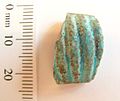File:Fragment of Roman melon bead, back (FindID 66807).jpg
Fragment_of_Roman_melon_bead,_back_(FindID_66807).jpg (598 × 476 pixels, file size: 39 KB, MIME type: image/jpeg)
Captions
Captions
Summary edit
| Fragment of Roman melon bead, back | |||
|---|---|---|---|
| Photographer |
West Yorkshire Archaeology Service, Anna Marshall, 2004-05-11 15:48:57 |
||
| Title |
Fragment of Roman melon bead, back |
||
| Description |
English: Fragment of a faience Roman melon bead dating from the 1st-2nd century. The fragment has four slightly diagonal grooves, a buff core and traces of a bright turquoise glaze. S.Worrell adds: Faience melon beads were produced in a range of sizes and tend to have wide perforations and convex profiles with vertical or slightly diagonal grooves scored into the outside surface. They were produced in a wide range of blue shades ranging from turquoise to bright blue with a buff/greyish core although in many cases the glaze has completely disappeared or survives only in the grooves. They are found in very large numbers at some sites. Occasionally beads have been found in connection with burials in Britain, as in a Flavian cremation burial at Grange Road, Winchester which contained eight faience beads (Biddle 1967, 245 nos. 54-61, fig. 9). |
||
| Depicted place | (County of findspot) Tameside | ||
| Date | between 43 and 200 | ||
| Accession number |
FindID: 66807 Old ref: SWYOR-B626D6 Filename: roman melon bead1.jpg |
||
| Credit line |
|
||
| Source |
https://finds.org.uk/database/ajax/download/id/24842 Catalog: https://finds.org.uk/database/images/image/id/24842/recordtype/artefacts archive copy at the Wayback Machine Artefact: https://finds.org.uk/database/artefacts/record/id/66807 |
||
| Permission (Reusing this file) |
Attribution-ShareAlike License version 4.0 (verified 23 November 2020) | ||
| Other versions |
|
||
Licensing edit
- You are free:
- to share – to copy, distribute and transmit the work
- to remix – to adapt the work
- Under the following conditions:
- attribution – You must give appropriate credit, provide a link to the license, and indicate if changes were made. You may do so in any reasonable manner, but not in any way that suggests the licensor endorses you or your use.
- share alike – If you remix, transform, or build upon the material, you must distribute your contributions under the same or compatible license as the original.
File history
Click on a date/time to view the file as it appeared at that time.
| Date/Time | Thumbnail | Dimensions | User | Comment | |
|---|---|---|---|---|---|
| current | 17:03, 24 January 2017 |  | 598 × 476 (39 KB) | Fæ (talk | contribs) | Portable Antiquities Scheme, SWYOR, FindID: 66807, roman, page 151, batch count 1711 |
You cannot overwrite this file.
File usage on Commons
The following 2 pages use this file:
Metadata
This file contains additional information such as Exif metadata which may have been added by the digital camera, scanner, or software program used to create or digitize it. If the file has been modified from its original state, some details such as the timestamp may not fully reflect those of the original file. The timestamp is only as accurate as the clock in the camera, and it may be completely wrong.
| Camera manufacturer | NIKON |
|---|---|
| Camera model | E5400 |
| Exposure time | 5/19 sec (0.26315789473684) |
| F-number | f/2.8 |
| ISO speed rating | 53 |
| Date and time of data generation | 14:30, 9 May 2004 |
| Lens focal length | 5.8 mm |
| Orientation | Normal |
| Horizontal resolution | 300 dpi |
| Vertical resolution | 300 dpi |
| Software used | Adobe Photoshop Elements 2.0 |
| File change date and time | 13:43, 10 May 2004 |
| Y and C positioning | Co-sited |
| Exposure Program | Normal program |
| Exif version | 2.2 |
| Date and time of digitizing | 14:30, 9 May 2004 |
| Meaning of each component |
|
| Image compression mode | 4 |
| APEX exposure bias | 0 |
| Maximum land aperture | 3 APEX (f/2.83) |
| Metering mode | Partial |
| Light source | Unknown |
| Flash | Flash did not fire, compulsory flash suppression |
| Supported Flashpix version | 1 |
| Color space | sRGB |
| File source | Digital still camera |
| Scene type | A directly photographed image |
| Custom image processing | Normal process |
| Exposure mode | Auto exposure |
| White balance | Auto white balance |
| Digital zoom ratio | 0 |
| Focal length in 35 mm film | 28 mm |
| Scene capture type | Standard |
| Scene control | Low gain up |
| Contrast | Normal |
| Saturation | Normal |
| Sharpness | Normal |
| Subject distance range | Unknown |
| IIM version | 2 |


